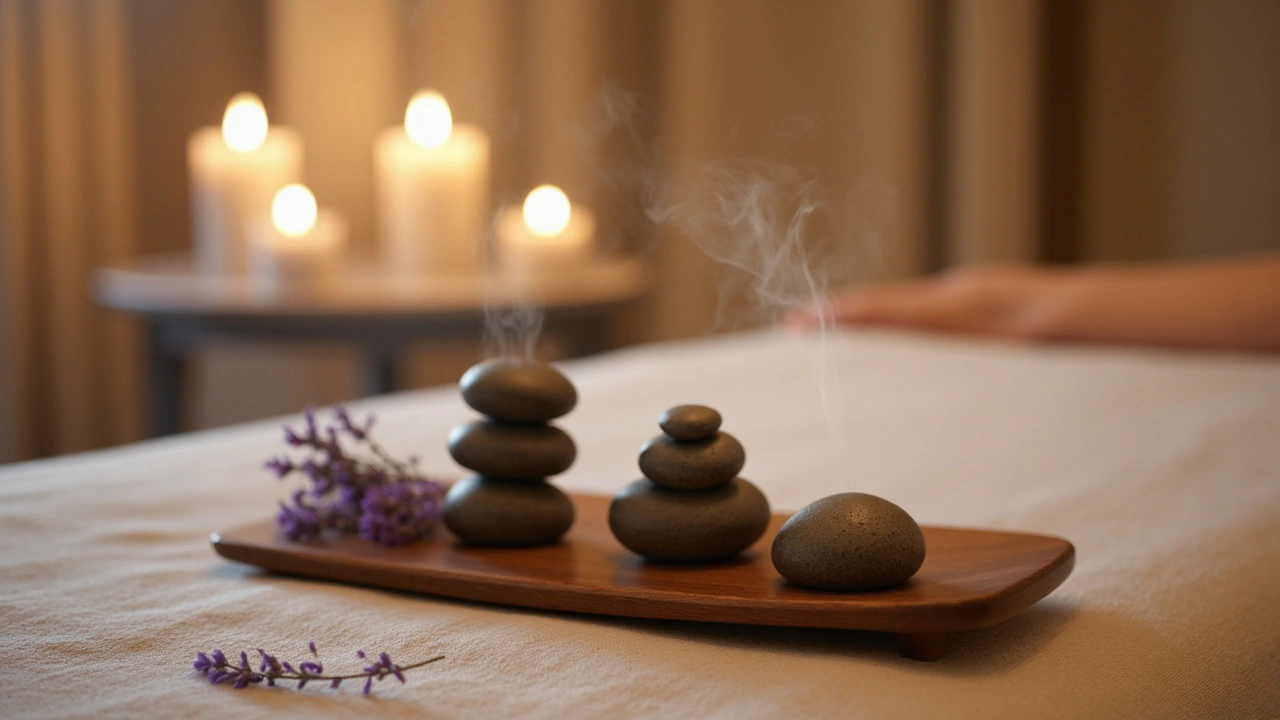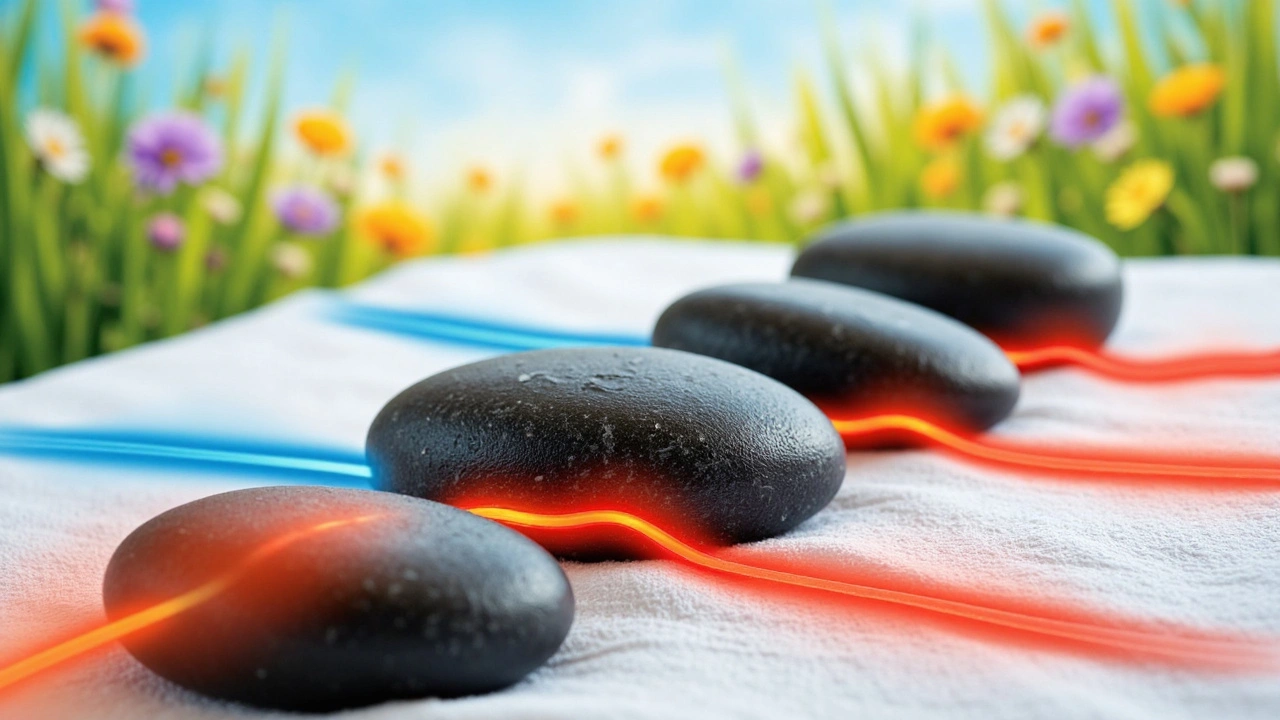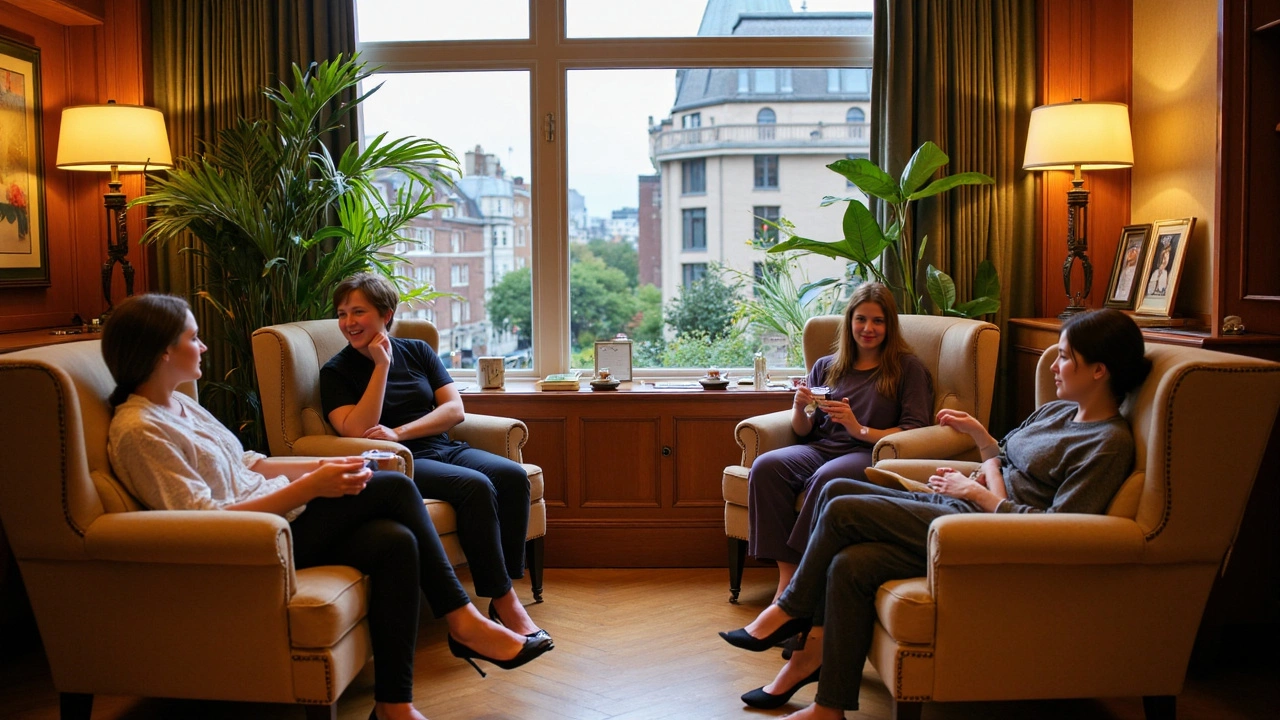Hot Stone Massage: Surprising Benefits You Didn't See Coming

If you think hot stone massage is just another spa trend, think again. The simple act of placing flat, heated stones on your body can make a huge difference in the way you feel—physically and mentally. People rave about walking out of a session feeling lighter, looser, and way less stressed.
These small, smooth stones kick things up a notch, especially for those with stiff muscles or stubborn aches. The heat helps muscles unwind faster, which means your therapist can work spots that would normally fight back. If you’re dealing with desk-job stiffness or hours of hardcore training, this kind of massage isn’t just about luxury—it’s practical self-care.
Here’s the cool part: Hot stone massage goes way beyond pain relief. Studies show it can actually improve blood flow and reduce anxiety levels in people who get regular treatments. Ever notice how lying in a hot bath melts tension away? Imagine that, but targeted just where your body needs it most. That’s what these sessions deliver, minus the pruny fingers.
- How Hot Stone Massage Actually Works
- Physical Perks: Beyond Relaxation
- Mental and Emotional Benefits
- Who Should (and Shouldn’t) Try It
- Tips for Getting the Most Out of Your Session
How Hot Stone Massage Actually Works
So what’s really happening during a hot stone massage? It all comes down to science and a little bit of old-school wisdom. The therapist uses basalt stones—these are volcanic rocks chosen because they hold heat longer than other stones. The stones are typically heated to around 120–130°F (that’s about 49–54°C), which is just warm enough to relax your muscles without burning you.
Here’s how a typical session plays out:
- The therapist sanitizes stones, heats them in water, and checks their temperature for safety.
- Warm stones are placed on key spots like your back, shoulders, and sometimes even your palms or feet.
- The therapist might glide the stones over your skin in smooth strokes, or leave them in place to target muscle knots and problem areas.
- Sometimes, they alternate between hot stones and classic hand massage to double up the benefits.
The magic isn’t just from the heat. The direct contact helps boost circulation, which brings more nutrients and oxygen to your muscles. This can make your body repair itself faster—from tough workouts or regular, day-to-day tightness.
The National Center for Complementary and Integrative Health points out that the heated stones can go deeper than hands alone. Warm muscles let your therapist dig in more effectively, but with less discomfort—so you get that relief without the usual next-day soreness.
| Aspect | Details |
|---|---|
| Stone type | Basalt (volcanic) |
| Average temp | 120–130°F (49–54°C) |
| Target areas | Back, shoulders, legs, hands, feet |
| Main effects | Muscle relaxation, pain relief, improved circulation |
Not every stone is the same, by the way. Good therapists use stones that match the shape of different body parts—a wide one for your lower back, slim ones for your arms or neck. It’s all about precision. That’s how hot stone massage hits those stubborn knots regular techniques don’t always reach.
Physical Perks: Beyond Relaxation
Hot stone massage isn’t just chill time; it comes with solid science-backed upsides for your body. The main thing people notice is how the warm stones boost circulation. When the heat soaks into your muscles, your blood vessels expand. This gets more oxygen and nutrients flowing, which means faster recovery and better overall muscle health. That’s a big win for anyone who works out hard, stands all day, or just wants less soreness after their daily grind.
One well-known fact: steady heat helps muscles loosen way quicker than pressure alone. This lets your massage therapist dig deeper—without making you wince. Folks with chronic neck and back pain often report longer-lasting relief compared to classic massage. The warmth can even ease joint stiffness, making it a smart pick for people with arthritis or everyday aches as they get older.
Muscle recovery gets another boost because the massage triggers the body's natural pain blockers—endorphins. This doesn’t just feel good; it helps break the cycle of pain and tension so you actually move better the next day.
- Improved blood flow, which helps muscles repair faster
- Reduced muscle tension, for deeper, longer-lasting relief
- Less joint stiffness (especially handy if you type a lot, lift, or are simply getting older)
- Fewer tension headaches and fewer episodes of back pain
Even the immune system reaps some benefits. A session can lower cortisol—the body’s main stress hormone—which supports a healthy immune response over time.
| Physical Benefit | What Science Says |
|---|---|
| Better circulation | Blood flow increases by up to 20% after heated stone therapy (Journal of Alternative and Complementary Medicine, 2022) |
| Muscle relaxation | Muscle tension drops faster compared to regular massage alone |
| Pain relief | Clients with back pain report up to 30% less pain for a week after hot stone sessions |
If you’re always nursing muscle knots or dragging yourself out of bed with aches, adding hot stone massage to your routine isn’t just feel-good stuff. It’s a practical way to handle real-life problems and keep moving like you want to.

Mental and Emotional Benefits
Hot stone massage isn’t just about physical perks—your mind gets a big boost, too. First off, the combination of heat and touch signals your body to dial down stress hormones like cortisol. A 2022 review from the Journal of Bodywork and Movement Therapies found that people who got hot stone massage regularly reported lower anxiety and better sleep.
There's a clear mental shift after a session. A lot of folks say their minds feel "unclenched"—it’s easier to let go of nagging thoughts. The warmth actually helps the nervous system switch from fight-or-flight to rest-and-digest mode, which is your body’s way of chilling out. Through this process, your body gets flooded with more serotonin and dopamine, those feel-good chemicals everyone’s always chasing.
The biggest win? A lot of people notice a steadier mood and less irritability in the days after their massage. Here’s a simple breakdown of mental outcomes people have reported:
- Sharp drop in stress levels during and after the session
- Better quality of sleep that same night
- More focus and mental clarity at work or school
- Easier time dealing with little everyday annoyances
If you look at the research, there’s hard data, too. Here’s what they found in a study group comparing regular massage to no massage:
| Group | Reported Lower Anxiety | Reported Better Sleep | Mood Improvement |
|---|---|---|---|
| Hot Stone Massage | 68% | 72% | 65% |
| No Massage | 31% | 28% | 22% |
Anyone dealing with work burnout or feeling generally overwhelmed may find a regular hot stone massage does more than just relax muscles—it relaxes your whole mood. Ever tried one right before a big week? The calm tends to last, helping you roll with whatever comes your way.
Who Should (and Shouldn’t) Try It
Hot stone massage sounds pretty awesome, but it’s not for everyone. Let’s get straight to the point. If you deal with muscle stiffness, tension headaches, ongoing stress, or trouble sleeping, you could really benefit from this therapy. It’s especially popular among athletes, office workers with tight backs, and folks recovering from tough workouts. The heat makes muscles more flexible, letting the therapist dig in without causing pain. Some regulars notice smoother movement or less soreness after sessions.
Now, not everyone should jump on the table. If you have certain health conditions, a hot stone massage might do more harm than good. It’s best to steer clear if you:
- Have open wounds or skin infections
- Experience poor circulation or neuropathy (especially common with diabetes)
- Suffer from blood clotting disorders or take blood thinners
- Are pregnant without getting the green light from your doctor
- Recently had surgery
- Have heat sensitivity or easily get overheated
Dr. Mark Rapaport at Emory University once put it like this:
“Any time there is a risk of impaired sensation, hot stone massage should only be considered with medical guidance. The heat can be risky when you can’t feel it properly.”
If you’re not sure whether it’s safe, just ask your healthcare provider. That’s not being overly cautious—it’s smart self-care.
| Who Should Try It | Who Should Avoid It |
|---|---|
| Muscle tension sufferers Chronic stress Desk job workers Recreational athletes Poor sleep quality Back and shoulder pain | Diabetes with neuropathy Blood clotting disorders Pregnancy (no doctor’s OK) Open wounds Skin conditions Recent surgery |
If you’ve never tried a hot stone massage and wonder how your situation fits in, a quick chat with your therapist can clear things up fast. Don’t hold back about your health history—better safe than sorry.

Tips for Getting the Most Out of Your Session
Booking a hot stone massage is just step one—there’s a lot you can do to get the most benefits. Showing up unprepared can mean missing out on deeper muscle relief, better relaxation, and an overall amazing experience.
Here are some things you should know before heading in:
- Hydrate well before and after. The heat and massage combo can leave you a bit dehydrated, so drink water before your session. Rehydrate after to help flush any toxins released from your muscles.
- Eat light, not heavy. Grab a small meal or snack a couple of hours before your appointment. A heavy meal right before can leave you feeling uncomfortable on the table.
- Arrive early. Give yourself time to wind down, use the restroom, and fill out any forms. If you rush in, your body will be tense and your mind all over the place.
- Communicate with your therapist. Don’t be shy about what hurts or what areas you want them to focus on. If the stones feel too hot, say something—they can swap them out or let them cool. You’re not being high-maintenance, just honest.
- Unplug your mind. Ditch your phone, close your eyes, and breathe deep. The more you let go mentally, the more benefit you’ll get physically.
- Don’t race to get up. Take your time after the massage. Sit for a couple of minutes, drink some water, and only stand when you feel steady.
Most people notice the best results with regular sessions. Even just once a month can make a difference if you have chronic tension or stress. Here’s a rough idea of how frequently folks choose to book:
| Session Frequency | Reported Benefits |
|---|---|
| Weekly | Major reduction in chronic pain, improved sleep, faster recovery after workouts. |
| Biweekly | Balanced stress levels, fewer muscle flare-ups, lasting relaxation. |
| Monthly | Maintenance of muscle flexibility, prevention of minor aches and tension. |
One last tip—if you’re nervous about your first session, ask for a quick walk-through from the therapist. Most are happy to explain every part so you feel in control. You paid for this, so make it work for you!



